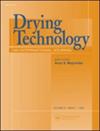脱脂奶粉两级喷雾干燥装置的热力学和运行经济分析
IF 2.7
3区 工程技术
Q3 ENGINEERING, CHEMICAL
引用次数: 0
摘要
牛奶喷雾干燥是一个高能耗的过程。本文对两段喷雾干燥装置进行了热力学和功耗经济分析。对该装置进行了能源效率、火用效率、能源改善潜力、火用改善潜力等参数分析。该装置的能量和火用效率分别为72.90%和35.15%。能量改进潜力最大的是干燥机,而能量改进潜力最大的是均质机。说明该厂干燥室和均质机的技术改进空间巨大。处理成本最高的是旋风分离器(相对成本差百分比为44%),其次是干燥室(相对成本差百分比为40.71%)。干燥室的能量破坏最高(195.83 kJ/kg),其次是VFBD (87.62 kJ/kg)。VFBD的能量效率最低(34.64%),其次是干燥室(50.04%)。估计干燥室的能量改善潜力最高(97.86 kJ/kg)。干燥室的相对能量破坏比最高(52.04%),其次是VFBD(23.30%)。干燥室的能量因子最高(28.22%),其次是均质器(16.71%)。在此基础上,认识到只要对干燥室和均质机进行设计改进,就可以大大提高喷雾干燥装置的性能。本文章由计算机程序翻译,如有差异,请以英文原文为准。
Thermodynamic and exergoeconomic analyses of two-stage spray drying plant for skim milk powder production
Abstract Spray drying of milk is a highly energy intensive process. In this study, thermodynamic and exergoeconomic analyses of two-stage spray drying plant have been executed. This plant was analyzed on the basis of various parameters such as energy efficiency, exergy efficiency, energy improvement potential, exergy improvement potential, etc. The energy and exergy efficiency of the plant were 72.90 and 35.15%, respectively. The maximum energy improvement potential was for drying whereas maximum exergy improvement potential was for homogenizer. It indicates huge scope in the technical improvement for drying chamber and homogenizer of the plant. The highest cost of processing was for cyclone separator (percentage relative cost difference: 44%) followed by drying chamber (percentage relative cost difference: 40.71%). Highest energy destroyed was calculated for drying chamber (195.83 kJ/kg) followed by VFBD (87.62 kJ/kg). Lowest energy efficiency was calculated for VFBD (34.64%) followed by drying chamber (50.04%). Highest energy improvement potential was estimated for drying chamber (97.86 kJ/kg). Highest relative energy destruction ratio was calculated for drying chamber (52.04%) followed by VFBD (23.30%). Highest energetic factor was calculated for drying chamber (28.22%) followed by homogenizer (16.71%). Based on these analyses, it was realized that performance of the spray drying plant may be substantially improved by some design improvement of drying chamber and homogenizer only.
求助全文
通过发布文献求助,成功后即可免费获取论文全文。
去求助
来源期刊

Drying Technology
工程技术-工程:化工
CiteScore
7.40
自引率
15.20%
发文量
133
审稿时长
2 months
期刊介绍:
Drying Technology explores the science and technology, and the engineering aspects of drying, dewatering, and related topics.
Articles in this multi-disciplinary journal cover the following themes:
-Fundamental and applied aspects of dryers in diverse industrial sectors-
Mathematical modeling of drying and dryers-
Computer modeling of transport processes in multi-phase systems-
Material science aspects of drying-
Transport phenomena in porous media-
Design, scale-up, control and off-design analysis of dryers-
Energy, environmental, safety and techno-economic aspects-
Quality parameters in drying operations-
Pre- and post-drying operations-
Novel drying technologies.
This peer-reviewed journal provides an archival reference for scientists, engineers, and technologists in all industrial sectors and academia concerned with any aspect of thermal or nonthermal dehydration and allied operations.
 求助内容:
求助内容: 应助结果提醒方式:
应助结果提醒方式:


